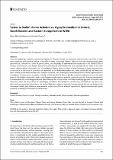Files in this item
‘Letter to Stalin’ : Roma activism vs. Gypsy nomadism in Central, South-Eastern and Eastern Europe before WWII
Item metadata
| dc.contributor.author | Marushiakova-Popova, Elena | |
| dc.contributor.author | Popov, Veselin | |
| dc.date.accessioned | 2020-06-04T15:30:02Z | |
| dc.date.available | 2020-06-04T15:30:02Z | |
| dc.date.issued | 2020-06-04 | |
| dc.identifier | 266451920 | |
| dc.identifier | 6a988951-b625-4a99-a8d4-d5d2e97be831 | |
| dc.identifier | 000539206300002 | |
| dc.identifier | 85090683357 | |
| dc.identifier.citation | Marushiakova-Popova , E & Popov , V 2020 , ' ‘Letter to Stalin’ : Roma activism vs. Gypsy nomadism in Central, South-Eastern and Eastern Europe before WWII ' , Social Inclusion , vol. 8 , no. 2 , 2777 , pp. 265-276 . https://doi.org/10.17645/si.v8i2.2777 | en |
| dc.identifier.issn | 2183-2803 | |
| dc.identifier.other | ORCID: /0000-0001-5333-2330/work/75248682 | |
| dc.identifier.other | ORCID: /0000-0002-6565-8730/work/75248702 | |
| dc.identifier.uri | https://hdl.handle.net/10023/20047 | |
| dc.description.abstract | From the beginning, academic research on Gypsies in Western Europe has presented their nomadic way of life as their most important and essential feature, a key pillar of their community identity. Measures for their sedentarisation were perceived as a shackle in a chain of persecutions, and the policy of sedentarisation conducted in the 1950s–1970s in Central, South-Eastern, and Eastern Europe has continuously been interpreted as an example of the crimes of the communist regimes against the human and cultural rights of Roma. What has been missing, however, in these interpretations is the stance on the issue of nomadism as expressed by the Roma themselves and, more specifically, by the Roma civic elite: namely, by the Roma activists who initiated the Roma civic emancipation and created the first Roma organizations in the regions. In recent years, a need to critically re-think the field of Romani Studies in order to take into account the viewpoint of the studied community comes in the foreground of academic and civil society discussions. Such re-consideration is unavoidable also in studying the field of Roma history. This article strives to fill this knowledge gap and to initiate a new discussion about the issue of the so-called Gypsy nomadism. The viewpoints on this issue, coming from the Roma civic elite itself, are presented primarily on the basis of historical evidence from the interwar period, but are not limited to its framework. Finally, later historical developments in the issue of Roma activists’ approach to Gypsy nomadism will also be outlined, including its contemporary dimensions. | |
| dc.format.extent | 22 | |
| dc.format.extent | 300131 | |
| dc.language.iso | eng | |
| dc.relation.ispartof | Social Inclusion | en |
| dc.subject | Central Europe | en |
| dc.subject | Eastern Europe | en |
| dc.subject | Gypsy nomadism | en |
| dc.subject | Interwar period | en |
| dc.subject | Roma activism | en |
| dc.subject | Roma organizations | en |
| dc.subject | D901 Europe (General) | en |
| dc.subject | T-NDAS | en |
| dc.subject | BDC | en |
| dc.subject | R2C | en |
| dc.subject | SDG 16 - Peace, Justice and Strong Institutions | en |
| dc.subject.lcc | D901 | en |
| dc.title | ‘Letter to Stalin’ : Roma activism vs. Gypsy nomadism in Central, South-Eastern and Eastern Europe before WWII | en |
| dc.type | Journal article | en |
| dc.contributor.sponsor | European Research Council | en |
| dc.contributor.sponsor | European Research Council | en |
| dc.contributor.institution | University of St Andrews. School of History | en |
| dc.contributor.institution | University of St Andrews. St Andrews Institute for Transnational & Spatial History | en |
| dc.identifier.doi | https://doi.org/10.17645/si.v8i2.2777 | |
| dc.description.status | Peer reviewed | en |
| dc.identifier.grantnumber | 694656 | en |
| dc.identifier.grantnumber | 694656 | en |
This item appears in the following Collection(s)
Items in the St Andrews Research Repository are protected by copyright, with all rights reserved, unless otherwise indicated.

